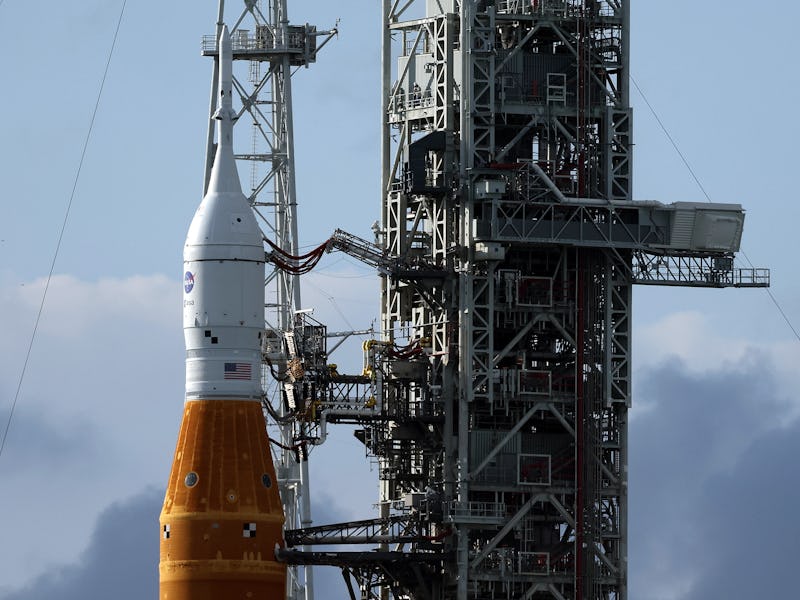NASA will attempt to launch Artemis I tonight — here's how to watch
Fifth time’s the charm.

Artemis I is scheduled to lift off Tuesday night (Wednesday morning for Eastern and Central time folk) despite a mild battering from Hurricane Nicole over the weekend.
NASA officials told the press that despite some superficial damage to insulation on the Orion capsule, the rocket was ready to fly. As of Tuesday afternoon, fuel loading on the craft was successful.
NASA announced on Monday that it would proceed with the mission. Hurricane Nicole caused problems with caulking called RTV material to delaminate. The agency was also detecting anomalous signals from the tail mast umbilical, a fuel line in the rocket, on Monday.
With launch night approaching, Inverse has the answers to all your questions about the Artemis I launch and the mission so far.
How to watch the Artemis I launch (and flight)
The rocket is set for launch at 1:04 a.m. Eastern on Wednesday and can be watched on NASA Live. The agency will begin live streaming before the launch at 10:30 p.m. Eastern tonight. Post-launch press conferences will take place at 4 a.m. Eastern time.
Starting one minute after liftoff, you can follow the Orion capsule on its journey to the Moon and back on NASA’s Artemis Real-time Orbit Website, or AROW (a clever pun on the Greek goddess Artemis’ skill at archery). The site visualizes data from sensors on the Orion spacecraft, providing information about its position, speed, alignment, and other flight details.
A few hours after launch, Orion will send home a few photos of Earth as it recedes into the distance, and NASA will keep sharing photos and videos from space throughout the mission. Commander Moonikin Campos, a mannequin testing NASA’s new Orion Crew Survival System spacesuit, will even have his own livestream during the flight, although you probably shouldn’t expect much detailed commentary from the notoriously taciturn Campos.
What is Artemis I?
Artemis I is NASA's uncrewed test of the Space Launch System rocket and the Orion crew capsule.
To make sure the rocket, the capsule, and the planned route to the Moon are safe enough to send astronauts to the Moon in, NASA engineers will collect masses of data from sensors and recorders in the capsule. Artemis I also uses sensor-laden mannequins aboard the flight to test new spacesuits, vests to protect astronauts against radiation, and seats in the Orion capsule.
All of that data will tell NASA's engineers whether the mission is safe to fly, or what needs to be changed to make it safe. It will also help design more realistic training simulations for the astronauts who will fly on the Artemis II and Artemis III missions later on.
What’s NASA’s backup plan for the Artemis I launch?
If NASA needs to postpone the Artemis I launch yet again, its next backup date is November 19. And just in case the need arises, NASA has scheduled another backup launch date for November 25. The latter places it the day after Thanksgiving. The James Webb Space Telescope launched early Christmas morning 2021, so that time is ... almost fitting.
What has delayed the Artemis I launch?
The Artemis I mission’s last launch date, November 14, was pushed back to allow engineers time to inspect the rocket in the wake of Hurricane Nicole, which made landfall on Florida’s space coast November 9. Based on their assessment of weather forecasts at the time, NASA officials decided it was safer for the rocket to weather the storm at the launch pad than to risk rolling it back to shelter of the Vehicle Assembly Building in high winds.
November 14 had been a rain date after Hurricane Ian struck Florida in late September, forcing NASA to reschedule its plans for a September 27 launch. And the September 27 date, in turn, had been delayed from September 19. All of that rescheduling followed two scrubbed launch attempts, one on September 3 and the very first on August 29.
Those first two launch attempts were scrubbed due to technical problems — specifically, a series of leaks in the fueling system for the SLS rocket’s liquid hydrogen propellant.
Earlier this month, Cliff Lanham, senior vehicle operations manager for the Exploration Ground Systems Program at Kennedy Space Center, told the press that the Artemis team had figured out how to manage the leak by controlling fuel pressures while filling the hydrogen tank, but they still don’t know what caused the problem in the first place.
“There’s not really a smoking gun, per se,” said Lanham.
Did Hurricane Nicole damage Artemis I?
A few times during the storm, wind speeds at the launch pad exceeded what the rocket was technically designed to withstand — after all, rockets are designed to fly straight up, not to withstand lots of wind pressure from the side, which typically doesn’t happen if a launch is going well.
That sparked some criticisms of the decision to leave Artemis I at the pad instead of retreating to the shelter of the Vehicle Assembly Building, but Jim Free, associate administrator for NASA’s Exploration Systems Development Mission Directorate, explained on November 11 that trying to move the rocket in the rising winds as Nicole approached would have put even more strain on its structure than sitting still at the launch pad.
And NASA officials have said repeatedly over the last few days that there’s no damage that would prevent the rocket from launching and flying safely. Among the damage reported is a long, thin strip of insulation – about an inch thick and 10 feet long which peeled away from a small gap in the Orion spacecraft. According to NASA, its loss won’t expose the capsule to too much aerodynamic heating, and there’s no risk of it falling off and damaging the capsule or the rocket during launch.
This article was originally published on